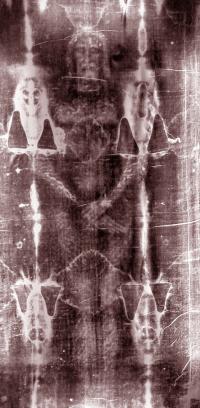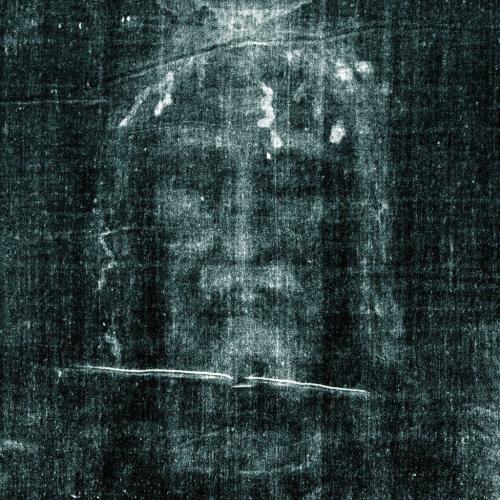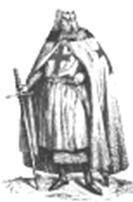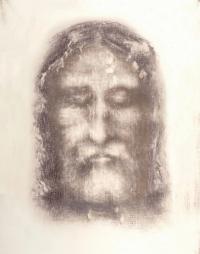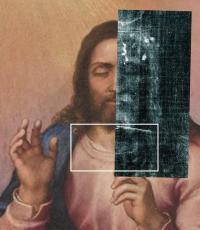The image of the Shroud
The Shroud: part 3

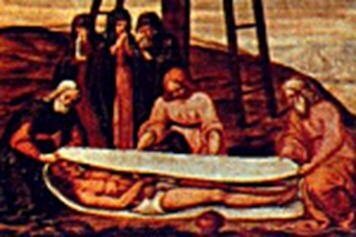
Can the image imprinted on the Shroud cloth be a painting? and if it is not, how was it possible that it was formed? we will now try to see some of the arguments in favor of one or the other hypothesis.
To confirm the hypothesis that the image of the shroud was formed entirely naturally, various tests where carried out by different laboratories. But even before the scientific evidence, some scientists have pointed out an extremely obvious fact: the obscure medieval forger who in the attempt to deceive humanity would have produced the Sindone, how could he know the technique of the negative if the photograph was discovered 600 years later? And furthermore, how could he have affixed on the man's eyelids two coins from that era (33 AD) that Baima Bollone found on the cloth if they were mentioned only in the middle of 1850? how is it possible that whoever made the false has foreseen this detail as well?
As far as the coins are concerned, everything seems to confirm that they are coins issued at the time of Pontius Pilate, in 29 AD. would seem to confirm that the Shroud dates back to the 1st century AD. But there are those who claim that only Baima Bollone saw them, interpolating apparent, and only apparent, tiny spots that appear on the images of the cloth and matching them with the inscriptions of ad hoc coins. A pathologist who dealt with fingerprints would be very embarrassed by Bollone's considerations, and by his confidence in the existence of coin images.
Here are the words of Luigi Gonella, physicist at the Polytechnic of Turin and scientific consultant to Cardinal Ballestrero, at the time of the STURP study on the shroud:
"That of the Shroud is an image whose smallest detail, blood stains excluded, is of half a centimeter. Like lips. It therefore appears very, very incongruent that there are details of the order of tenths of a millimeter like the letters on coins. But you know: by dint of zooming in, you end up seeing what is not there . [...] "
Moreover, the coins, real or reproduced, could easily be found even in 1200, the year of the C14 dating, so this does not appear conclusive. There are therefore infinite doubts about the fact of the coins. But, with regard to the accuracy of the forger, we should also keep in mind that the forger himself, if he existed, may have done extensive research, before, to reproduce a fake in a workmanlike manner, and perhaps even several proofs. Besides, he was reproducing The Relic, not just any copy of any fetish.
But let's go back to the image of the body represented on the Shroud; what could have leaved suck mark? one of the first things that comes to mind is of course the bleeding due to the crucifixion and the blow of a spear in the side.
So let's see what has been stated about
The Crucifixion
The crucifixion of man is a Roman-type crucifixion, which makes use of a "removable cross" made up of a long vertical pole called "Stipes" which was planted outside the city (in our case ... in the place called "cranio", the mount Calvary).
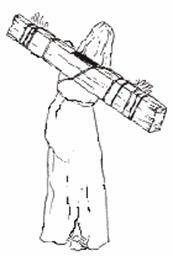
The second part of the "cross", the "Gallow", was applied to the condemned man long before his arrival at the place of execution, already in the city at the time of the sentence, but at first the condemned man was not nailed to this pole but there was just tied up.
As everyone knows, Jesus was not directly nailed to the cross, first there was a "regular" trial, after which the man of the shroud was whipped.
"... Supra dorsum meum araverunt aratores ... they made my body like a plowed field"
this description can give an excellent idea of how hard and long was the scourging of Jesus, approximately 100-120 strokes of scourge, given by two flagellators, placed on either side of the column to which the condemned man is thought to have been tied; according to the studies made by Noghier, Vignon and G.B. Judica Cordiglia, it can really be the column brought in 1213 by Cardinal Colonna to the church of S. Praxedes: a pillar of just 64 centimeters.
On the head of the man of the shroud a helmet of thorns was placed and this is testified by the presence of numerous drips that appear just above the face, on the part of the shroud that wrapped the nape of Jesus. All these drippings show without a doubt that the condemned man received many blows, especially on the right hemisphere (which appears more swollen than the other) such as to induce him to bend his face on the other side, causing the blood to flow on the other side. . from the direction of the casting we can also deduce the position held by the convict during the crucifixion.
How was the man of the shroud crucified? Certainly on the ground he was crucified through the use of two square iron nails which penetrated into the wrist and not into the hand as many mistakenly think, the nail penetrated into the so-called space of Destot, where the conformation of the body allows to maintain such a heavy weight for so long. If the man had been nailed to his hands he would have fallen in minutes. His feet, on the other hand, were fixed to the lower part of the cross with a single nail: and that was the only support he had, for that man's 75 kilos of weight.
By observing the shroud, it is possible to notice with surprise that the thumbs are missing, we must absolutely not think about a malformation or anything else, the thumbs are just that it is not possible to see them, because, the space of Destot contains a nerve that if touched, causes the thumb to retract inside as if it had been glued to the palm and obviously an inhuman and tearing pain.
and about death
How did the death of the man of the shroud happen? According to what the doctors say, the death of the man of the shroud occurred due to severe breathing problems due to the position held by the condemned during the hours in which he was crucified. The death was due to tetanic cramps, for which the respiratory muscles cause asphyxiation, because always tense in exhalation, but this is not the only alternative, some speak of the so-called orthostatic collapse for which all the blood present in the body fell towards the low part of the body,

not flowing to the heart and brain and causing almost instant death. There is a third thesis, death by haemopericardium, or the breaking of the heart, a thesis defended by those who justify Jesus' acute cry before death: "Imma", in english "Mom".
and science says that
"The X-ray examination of the Shroud showed the existence of two different types of blood - arterial and venous - precisely in the points where it was expected to be found.If the Shroud were a forgery from the 1300s, the author would have been a seer, because the different blood circulation is a medieval discovery from 1593"
First of all what you see on the Shroud is blood belonging to the AB group, and therefore human, and also studies on the force of gravity applied to the Shroud and to the dripping of its blood have given further confirmation to the fact that the man of the Shroud was killed through crucifixion. Further studies on blood have also "established" the times of the deposition and those of stay in the tomb. Jesus died after 3 hours of agony, according to the doctors, death was one of the most painful. After his death but not much later, a cloak was laid and probably passed to him under the kidneys, he was taken to the tomb, where he was raised and placed on the shroud, which bears the fingerprints of one of the stretcher bearers on the foot area
"At 18:08 the sun set and soon the stars would appear, the third appeared at 19:08: about half an hour was needed to go to Pilate to ask for the body and return to take it less than 30 minutes would not have been necessary to complete all the rituals necessary for the burial, so Maria, and the others gave up the undertaking and temporarily wrapped the body in this linen waiting for the next day, at 7:09 pm it was Saturday and no one could work anymore "
However, researches go further (it should be noted that the dates and times have been calculated on the basis of astronomical rules that may be subject to even minimal errors); according to some calculations, Jesus remained in the sepulcher for only 40 hours after which the resurrection took place (by 5-6 in the morning) after which the decomposition of the body would begin (which as the scriptures affirm did not happens).
... there even spectrographic tests have been made
The spectral reflection of the burn areas (the fire in Chambery in 1532) and of the body image were very similar. In fact, as a consequence of a series of spectroscopy investigations carried out with infrared reflections made by J. S. Accetta and J. S. Baumgart in 1978 it was possible to compare the spectral characteristics of the selected characteristics of the Shroud (areas of blood stains, body image, original and uncorrupted linen and burn marks and water marks caused by an accidental fire in 1532). In particular, it was found that no notable difference exists between the spectral characteristics of the burn marks and those areas of the canvas that contained the anatomical details of the image. Spectral comparisons made between the scrub areas and the burn areas exhibited similar characteristics in the bands in 3-5 and 8-14 nm of spectrographic band. Indeed, it was discovered that there is a conspicuous correspondence between the image and the burn areas in both spectral bands. However, considering the way it was done, the burn produced in both cases was dissimilar (in one it was caused by a chemical reaction, the other by direct heat) and it is no wonder that the burn marks have passed in a short time from a reddish to a yellow-green fluorescence in ultraviolet light, the image of the body of the Shroud, with the bloodstains that are not fluorescent.
... but there is something more
- we admit that the C14 test was wrong
- let's assume that the Shroud is really from the first century AD. (neutrons, coins)
- let's assume it comes from Palestine (pollen)
- let's assume it contained a body
- forget for a moment the "mask" that is not seen but should. Well, would this show that it is “that” cloth, that is, the cloth that wrapped “that” specific body? Obviously not. The impossible work of proving that it is the true shroud of Christ, and not just any rag of any crucifix, should still be done. Of course, one could easily object that precisely because it is a particular phenomenon, the Shroud cloth is understood to belong and unequivocally belong to "that" Jesus and not to others.
But the opposite faction presses: if the body of Christ had been washed and sprinkled with myrrh and aloe, as some Gospels say, they would have no reason to be the imprints of blood, instead abundant enough unless the blood is shed afterwards, but this would imply a detachment from the cross of a person still alive.
The presence of blood on the cloth is proof that the corpse was not washed before being wrapped in it, justifiable only in the case of a Jewish burial, prior to 70 AD and perfectly coinciding with what is narrated by the Gospels. It was close to Easter. Jewish and being dark by now on Friday evening when Jesus was lowered from the cross, the washing of the body was postponed to the following Sunday (on Saturdays it was forbidden to officiate worship). An interesting statistical study by Professor Bruno Barberis has shown that out of 200 billion hypothetical crucified individuals, only one could have possessed the same characteristics common to Jesus and the man of the Shroud. But is this enough to say that the Shroud is really the image of Christ?
And again: the blood is very red, while it should darken in a short time. On the other hand, those who assert the authenticity of the Shroud affirm that this is due to the fact that it was treated with preservatives, in fact from analyzes carried out in 1973 by a commission set up by Cardinal Pellegrino no traces of red blood cells were found, on the contrary traces of a red dye.
Other analyzes performed with a test (which is not specific for blood, so much so that it can also be positive on traces of plant origin) showed instead the presence of blood. In 1980 McCrone found, analyzing the previous results, traces of red ocher, cinnabar and alzarin, and the presence of a binder. That is, he found the presence of tempera colors. Then, other analyzes, instead confirmed the presence of blood of the AB group. The question is this: if the Shroud is a fake, then the presence of both blood and dyes could be justified; but if it were true, why not just blood? And above all, how is it possible that there are such different, indeed conflicting results? In some cases is it science or faith that speak?










